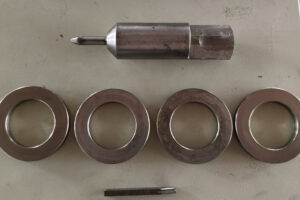Spring Processing Tooling: Design, Optimization, and Manufacturing Excellence
1. Introduction to Spring Processing Tooling
 Spring processing tooling represents the backbone of precision spring manufacturing, enabling the production of components that meet exacting dimensional and functional requirements. As a leading professional custom-made spring and wire forming manufacturer in China, ChinaCustomSpring leverages cutting-edge tooling solutions to deliver high-performance springs for automotive, aerospace, medical, and industrial applications.
Spring processing tooling represents the backbone of precision spring manufacturing, enabling the production of components that meet exacting dimensional and functional requirements. As a leading professional custom-made spring and wire forming manufacturer in China, ChinaCustomSpring leverages cutting-edge tooling solutions to deliver high-performance springs for automotive, aerospace, medical, and industrial applications.
This comprehensive guide explores the intricacies of spring processing tooling, covering:
-
Fundamental principles and classifications
-
Advanced design methodologies
-
Critical technical parameters and calculations
-
Applications across various spring types
-
Emerging trends and future innovations
2. Comprehensive Classification of Spring Tooling
2.1 Machine-Integrated Tooling
Modern spring manufacturing primarily utilizes computer-controlled coiling machines equipped with specialized tooling systems:
-
Wire Guides and Feed Mechanisms: Ensure consistent material delivery to the coiling point
-
Arbor and Mandrel Systems: Determine spring inner diameter (ID) characteristics
-
Pitch Control Tools: Regulate spacing between coils for compression/extension springs
-
Cut-off Mechanisms: Precision blades for severing finished springs
2.2 Stand-Alone Processing Tooling
For secondary operations and special applications:
| Tooling Type | Function | Key Characteristics |
|---|---|---|
| Forming Fixtures | Shape retention during heat treatment | Heat-resistant materials, dimensional stability |
| Cutting Dies | Precision severing of wire ends | Hardened tool steel, razor-sharp edges |
| Inspection Gauges | Dimensional verification | ±0.01mm tolerance, wear-resistant |
| Setting Devices | Stress relief and presetting | Programmable force application |
3. Advanced Design Methodology
3.1 Systematic Design Approach
The tooling design process follows seven critical phases:
-
Requirement Analysis
-
Review spring specifications (wire diameter, coil count, free length)
-
Identify functional requirements (load capacity, fatigue life)
-
Material selection considerations (music wire, stainless steel, alloy)
-
-
Process Planning
-
Develop manufacturing sequence (coiling → heat treatment → finishing)
-
Determine required tolerances for each operation
-
Select appropriate machine capabilities
-
-
Concept Development
-
Generate multiple design concepts
-
Evaluate using DFM (Design for Manufacturing) principles
-
Conduct FEA (Finite Element Analysis) for stress evaluation
-
-
Detailed Engineering
-
Create 3D models with parametric relationships
-
Specify critical dimensions and GD&T requirements
-
Select standard components (bearings, bushings, fasteners)
-
-
Prototyping and Testing
-
Build functional prototypes
-
Conduct production trials
-
Measure spring characteristics (force-deflection, permanent set)
-
-
Production Implementation
-
Finalize tooling documentation
-
Train operators
-
Establish maintenance procedures
-
-
Continuous Improvement
-
Monitor tooling performance
-
Implement wear compensation systems
-
Upgrade designs based on production feedback
-
3.2 Critical Design Considerations
Material Selection Matrix for Tooling Components:
| Component | Recommended Material | Hardness (HRC) | Special Treatment |
|---|---|---|---|
| Cutting Blades | D2 Tool Steel | 58-62 | Cryogenic treatment |
| Guide Bushings | Tungsten Carbide | 70+ | Precision grinding |
| Forming Pins | H13 Hot Work Steel | 48-52 | Nitriding |
| Fixture Plates | 4140 Alloy Steel | 28-32 | Stress relieving |
4. Technical Calculations and Parameters
4.1 Spring Coiling Mechanics
Wire Bending Stress Calculation:
Where:
-
σ = Bending stress (MPa)
-
F = Forming force (N)
-
D = Coiling diameter (mm)
-
d = Wire diameter (mm)
Coiling Torque Requirement:
Where:
-
T = Required torque (Nm)
-
τ = Material shear strength (MPa)
-
Kw = Wahl correction factor
4.2 Tolerance Stack-Up Analysis
Composite Positioning Error:
Spring Diameter Control:
For optimal performance, maintain:
-
Inner diameter tolerance: ±0.5% of nominal
-
Outer diameter tolerance: ±0.75% of nominal
-
Free length tolerance: ±1% of nominal
5. Application-Specific Tooling Solutions
5.1 Automotive Suspension Springs
-
Tooling Challenges: High cyclic loading requirements
-
Solution:
-
Multi-stage coiling with intermediate stress relief
-
Shot peening fixtures for fatigue resistance
-
Automated inspection systems
-
5.2 Medical Device Springs
-
Special Requirements:
-
Ultra-fine wire handling (0.05-0.5mm)
-
Cleanroom-compatible materials
-
Micro-coiling capabilities
-
5.3 Industrial Heavy-Duty Springs
-
Tooling Features:
-
Reinforced mandrels for large diameters (up to 200mm)
-
Hydraulic clamping systems
-
Wear monitoring sensors
-
6. Emerging Technologies and Future Trends
6.1 Smart Tooling Systems
-
IoT-enabled condition monitoring
-
Predictive maintenance algorithms
-
Self-adjusting compensation mechanisms
6.2 Additive Manufacturing Applications
-
3D printed conformal cooling channels in heat treatment fixtures
-
Rapid prototyping of custom tooling geometries
-
Composite material tooling for lightweight applications
6.3 Sustainable Manufacturing Practices
-
Tooling life extension through advanced coatings
-
Energy-efficient drive systems
-
Closed-loop material recycling
7. ChinaCustomSpring’s Technical Capabilities
As a premier spring manufacturer in China, our facilities feature:
-
Advanced Tooling Workshop:
-
CNC grinding machines (±0.001mm accuracy)
-
Wire EDM capabilities
-
In-house heat treatment
-
-
Quality Assurance Systems:
-
Optical measurement systems
-
Force testing equipment (0.1% accuracy)
-
Material certification
-
-
Custom Engineering Services:
-
Prototype development in 5-7 days
-
Small batch production from 100pcs
-
Full documentation packages
-
8. Conclusion and Industry Outlook
The evolution of spring processing tooling continues to push the boundaries of manufacturing precision and efficiency. With ChinaCustomSpring’s expertise in custom tooling design and spring production, we stand ready to meet the most challenging technical requirements across all industries.
Future developments will focus on:
-
Increased automation and digital integration
-
Enhanced material science applications
-
Sustainable manufacturing processes
For your next spring manufacturing project, partner with a trusted China spring manufacturer that combines decades of experience with cutting-edge technological solutions.






